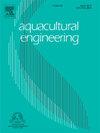Investigation of diameter-to-depth ratio on the hydrodynamics in recirculating aquaculture tank
IF 3.6
2区 农林科学
Q2 AGRICULTURAL ENGINEERING
引用次数: 0
Abstract
To maximize the spatial utilization rate of the recirculating aquaculture system (RAS) and improve the growth conditions of aquaculture varieties, the present study used the numerical simulation method to investigate the distribution characteristics of the flow velocity inside the aquaculture tank. It is of great practical importance for the design and optimization of the aquaculture tank structures. The computational fluid dynamics (CFD) method and the RNG k-ε turbulent model were applied to analyze the effects of diameter-to-depth ratio (L/H) on the hydrodynamic characteristics inside the aquaculture tank, including the average flow velocity, resistance coefficient, flow velocity uniformity, energy utilization coefficient, vortex and Fraud correction coefficients. The accuracy of proposed method was verified by experimental results. The results show that as the diameter-to-depth ratio (L/H) of the rectangular arc angle aquaculture tank increases, the turbulence intensity in the flow field gradually weakens, the low-velocity area increases, and the average flow velocity decreases. When the diameter-to-depth ratio (L/H) is 3:1–5:1, uniformity coefficients, energy effective use coefficients, and Fraud correction coefficients have significantly been improved, and the flow pattern in the aquaculture tank is the best. Through the research of the present study, it can effectively improve the utlization rate of aquaculture tank space, and provide technical support for the realization of the welfare aquaculture of the recirculating aquaculture system.
水产养殖循环池径深比对水动力的影响研究
为了最大限度地提高循环水养殖系统(RAS)的空间利用率,改善养殖品种的生长条件,本研究采用数值模拟的方法对养殖池内流速分布特征进行了研究。这对水产养殖水箱结构的设计和优化具有重要的现实意义。采用计算流体力学(CFD)方法和RNG k-ε湍流模型,分析了径深比(L/H)对养殖池内水动力特性的影响,包括平均流速、阻力系数、流速均匀性、能量利用系数、涡流和欺诈校正系数。实验结果验证了该方法的准确性。结果表明:随着矩形圆弧角养殖池径深比(L/H)的增大,流场湍流强度逐渐减弱,低速区增大,平均流速减小;当径深比(L/H)为3:1 ~ 5:1时,均匀性系数、能量有效利用系数和Fraud校正系数均有显著提高,且养殖池内的流态最好。通过本研究的研究,可以有效提高养殖池空间的利用率,为实现循环水养殖系统的福利养殖提供技术支持。
本文章由计算机程序翻译,如有差异,请以英文原文为准。
求助全文
约1分钟内获得全文
求助全文
来源期刊

Aquacultural Engineering
农林科学-农业工程
CiteScore
8.60
自引率
10.00%
发文量
63
审稿时长
>24 weeks
期刊介绍:
Aquacultural Engineering is concerned with the design and development of effective aquacultural systems for marine and freshwater facilities. The journal aims to apply the knowledge gained from basic research which potentially can be translated into commercial operations.
Problems of scale-up and application of research data involve many parameters, both physical and biological, making it difficult to anticipate the interaction between the unit processes and the cultured animals. Aquacultural Engineering aims to develop this bioengineering interface for aquaculture and welcomes contributions in the following areas:
– Engineering and design of aquaculture facilities
– Engineering-based research studies
– Construction experience and techniques
– In-service experience, commissioning, operation
– Materials selection and their uses
– Quantification of biological data and constraints
 求助内容:
求助内容: 应助结果提醒方式:
应助结果提醒方式:


